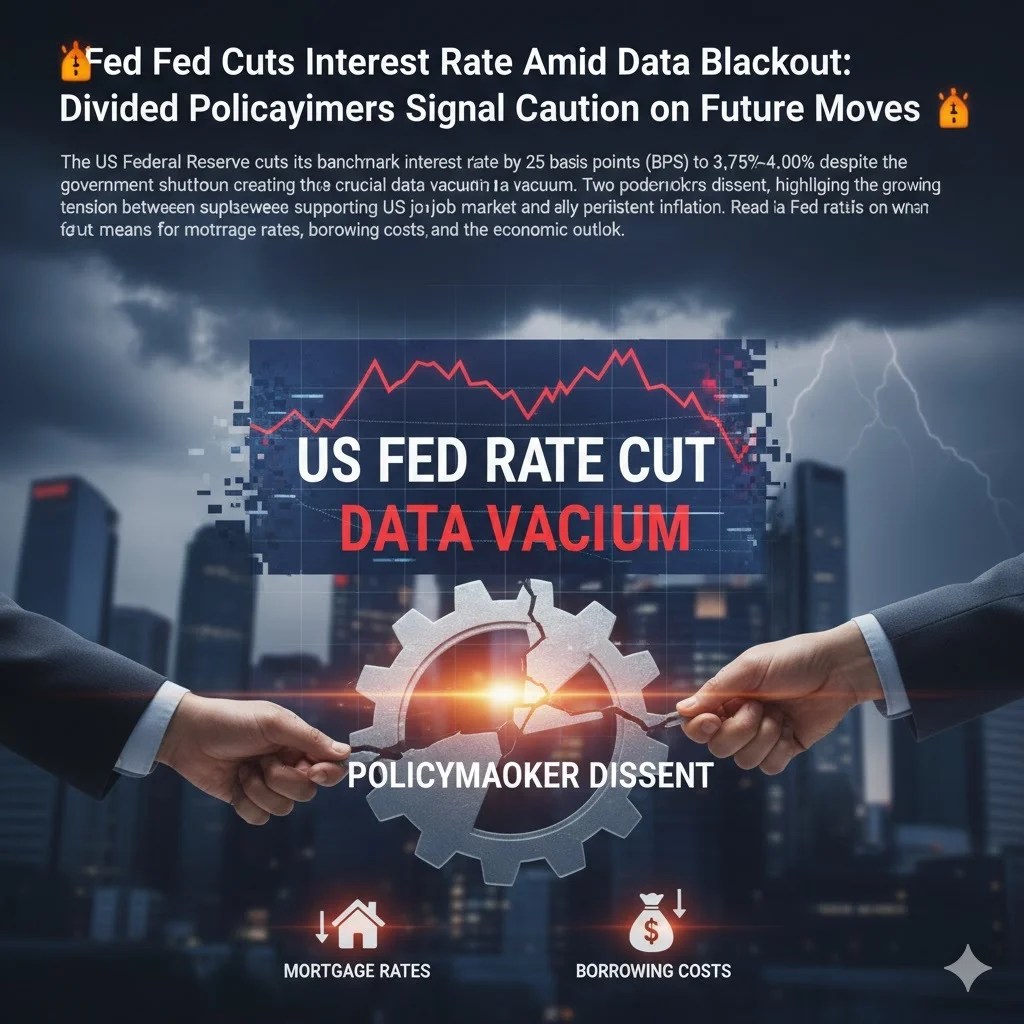New York] 30-October-2025: The US Federal Reserve (Fed), led by Chairman Jerome Powell, has delivered its second consecutive interest rate reduction this week, lowering the benchmark of federal funds rate by a quarter of a percentage point (25 basis points) to a range of 3.75% to 4.00%
This highly anticipated move is intended to inject support into a slowing the US labor market and buffer the economy against increasing global risks. However, the decision was complicated by an ongoing federal government shutdown, which has suspended the release of key economic reports, creating a significant data vacuum for policymakers. Additionally, the vote was marked by rare dual dissent, signaling a deep division on the path forward for Federal monetary policy.
Navigating the Economic Fog: Data Limitations Acknowledged
A defining feature of this month’s Federal Open Market Committee (FOMC) meeting was the central bank’s acknowledgment that it is, in Chair Powell’s words, driving in the fog. Key economic indicators, including the crucial important non-farm payrolls, retail sales, and inflation figures-have been delayed since the start of the government shutdown on October 1st.
The FOMC statement explicitly noted the limits of data during the shutdown, forcing policymakers to rely on stale figures (like the August jobs report) and alternative, less comprehensive private-sector indicators to measure the Federal economy’s health.
The official statement pointed to a significant cooling in the job market, with job gains slowing sharply over the last few months, even though the unemployment rate remained comparitavely low in the last available report. This increased risk to employment was the primary driver for the interest rate cut.
A House Divided: The Rare Dual Dissent
The 10-2 vote to cut the rate revealed a stark split among the central bank’s governing members, marking only the third time since 1990 that policymakers have dissented both in favor of easier and tighter monetary policy at the same meeting.
Governor Stephen Miran dissented, arguing for a more aggressive rate cut of a half-percentage point (50 BPS). His vote aligns with a desire for a greater reduction in borrowing costs to more forcefully shore up the faltering economic growth and job market.
Kansas City Fed President Jeffrey Schmid voted against the cut, preferring no change to the target range. His position is based on the lingering concern that US inflation, which remains stubbornly above the Fed’s 2% target, is still too high. Cutting rates, he argues, risks over-stimulating the economy and worsening price pressures.
This dual dissent underscores the challenging position the Federal Reserve finds itself in: balancing its two mandates of achieving maximum employment and maintaining price stability (low inflation) when the two goals are currently in conflict.
Key Takeaways for Markets and Consumers
The quarter-point Fed rate cut has several implications for both financial markets and everyday consumers:
Borrowing Costs and Financial Markets
Lowering the benchmark interest rate, translates to lower costs for banks to borrow money, which should eventually trickle down to consumers and businesses, This is expected to:
Reduce Mortgage Rates: As, consumers looking to buy a home or refinance a mortgage should see a gradual dip in mortgage rates, making housing slightly more affordable.
Lower Loan Costs: The cost of other loans, including auto loans and credit card debt, may also decrease.
Boost Stock Markets: Stock indexes initially held gains on the news, as lower rates typically boost corporate borrowing and spending. The US stock market is closely watching for signs of economic recovery.
Future Outlook: The December Uncertainty
Perhaps the most crucial takeaway for investors is Fed Chair Powell’s cautious tone regarding future action. He stressed that a further rate reduction at the final FOMC meeting of the year in December is not a foregone conclusion.
Powell indicated that the next decision will be data-dependent, meaning the future interest rate cuts depend entirely on the economic reports released once the government shutdown ends. The potential for continued data uncertainty may force the central bank to proceed even more cautiously, a possibility Powell openly acknowledged.
In a related move, the Federal Government also announced it would conclude the reduction of its $6.6 trillion balance sheet in December, a move aimed at easing tensions in short-term funding markets and providing additional liquidity to the financial system. This action provides another form of subtle monetary easing to support market stability.
The news surrounding the Fed’s decision provides fertile ground for US economy, Fed cuts interest rates, US job market, US inflation, monetary policy,
Federal Reserve interest rate decision, Jerome Powell press conference, mortgage rates forecast, Fed rate cut impact,
What does the Fed rate cut mean for my mortgage rate?, Why did two policymakers dissent on the Fed rate cut, Impact of government shutdown on US economic data, Future interest rate cuts 2025 forecast,
USA FOMC meeting, USA federal funds rate, basis points, USA borrowing costs, US economic outlook, US price stability, US Federal balance sheet reduction, federal reserve interest rate cut, fed rate cut,
fed rate cut news, interest rate cut federal reserve, us fed rate cut, fed meeting today, forex factory, nasdaq, us fed rate cuts, us fed meeting, fed, dow jones futures, fomc, fomc meeting, fed news,
fed rate cuts, fed rate, fed rate cut news today, fomc meeting today live, powell speech today, fed interest rate decision, fomc meeting today.


